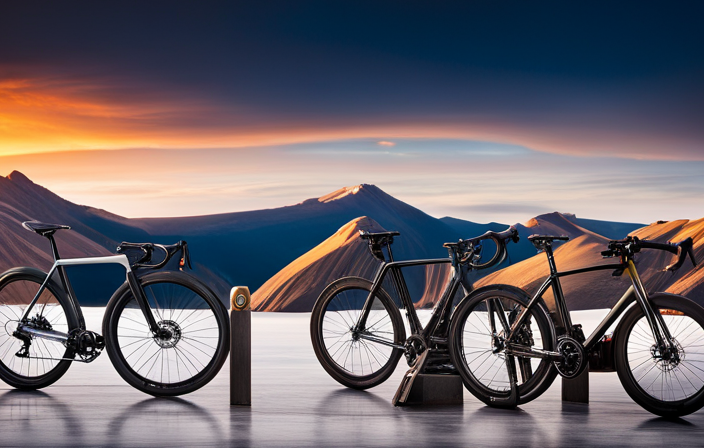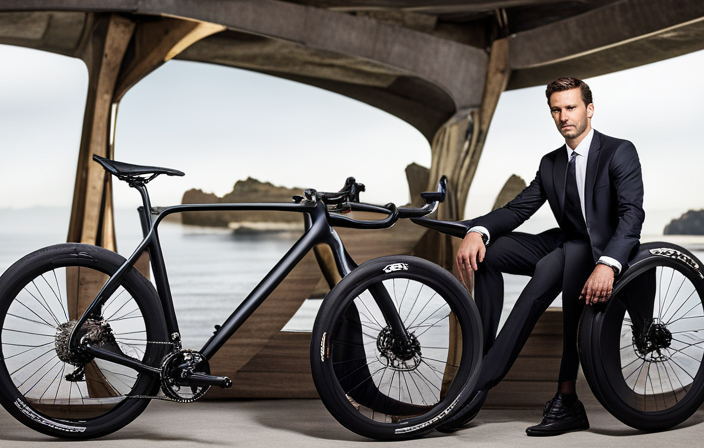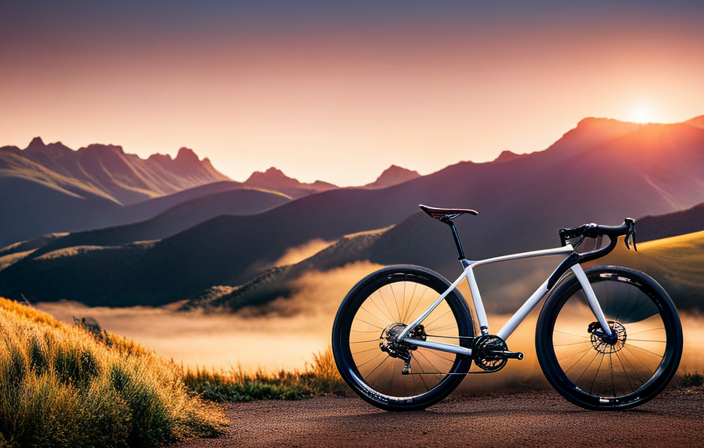Do you find yourself bored of riding on smooth, paved roads with your road bike? Have you ever thought about taking on challenging terrains and conquering adventurous trails? If that sounds like you, then it’s time to explore the realm of gravel bikes.
In this article, I’ll take you on a journey to discover the key differences between gravel bikes and road bikes. From their anatomy and design variations to their suitability for different riding styles, we’ll explore it all.
So buckle up and let’s hit the gravel!
Key Takeaways
- Gravel bikes are built for off-road adventures with wider tires and more tread for better traction, while road bikes are designed for smooth pavement with narrower tires and minimal tread.
- Gravel bikes have flared handlebars for increased stability, while road bikes have drop handlebars for aerodynamics.
- Gravel bikes have a more relaxed and upright riding position, while road bikes have an aggressive forward-leaning posture.
- Gravel bikes are suitable for rough terrains like gravel roads and dirt paths, while road bikes excel on smooth pavements and high-speed riding.
Anatomy and Design Differences
The main difference between a gravel bike and a road bike lies in their anatomy and design.
When it comes to terrain and riding style, the gravel bike is specifically built to handle off-road adventures and rough surfaces, while the road bike is designed for smooth pavement. Gravel bikes have wider tires with more tread, allowing for better traction on loose or uneven surfaces. This enables riders to confidently navigate through dirt paths, gravel roads, or even rocky trails without losing control.
Another notable difference is the handlebars and riding position. Gravel bikes typically feature drop bars like those found on road bikes, but they are often flared outwards at the ends. This provides riders with a wider grip for increased stability when tackling challenging terrains. Additionally, gravel bikes usually have a more relaxed and upright riding position compared to the aggressive forward-leaning posture of road bikes. This allows for better control and comfort during long rides on unpredictable surfaces.
In conclusion, the anatomy and design of both gravel bikes and road bikes cater to different terrains and riding styles. While gravel bikes excel in off-road adventures with their wider tires and stable handlebars, road bikes are optimized for speed on smooth pavements with their aerodynamic frame geometry. Understanding these differences is crucial in choosing the right bike for your specific needs.
Terrain and Riding Style
When it comes to the type of paths and how you ride, gravel bikes and road bikes differ. The terrain you plan on tackling and your preferred riding style are important factors to consider when choosing between these two types of bikes. Here are some key differences in handling and stability that can greatly impact your overall performance and speed:
- Gravel bikes are designed to handle rougher terrains such as gravel roads, dirt paths, and even light off-road trails. They usually have wider tires with more aggressive tread patterns, allowing for better traction on loose surfaces.
- Road bikes, on the other hand, are optimized for smooth pavement and high-speed riding. They feature narrower tires with minimal tread, which reduces rolling resistance but compromises their ability to handle uneven surfaces.
The differences in handling and stability between gravel bikes and road bikes directly affect your performance. Gravel bikes provide a more stable ride due to their wider tires and relaxed geometry, which enhances control over rough terrain. However, this added stability can come at the cost of speed on smoother roads where aerodynamics play a significant role.
Transitioning into the next section about handlebars and riding position, it’s worth noting that these components also contribute to the overall riding experience.
Handlebars and Riding Position
To optimize your riding experience, consider how handlebars and riding position can impact your comfort and control.
When it comes to gravel bikes and road bikes, there are some key anatomy and design differences in the handlebars that affect your riding position. Road bikes typically have drop handlebars, which allow for a more aerodynamic position with multiple hand positions. This is ideal for long rides on smooth pavement where speed is a priority. On the other hand, gravel bikes often have flat or flared handlebars that provide a wider grip and more upright riding position. This allows for better control on rough terrain and provides a more comfortable posture during longer off-road adventures.
The difference in riding positions between road bikes and gravel bikes also reflects the different terrains they are designed for. Road bike riders generally adopt a lower, more aggressive stance to maximize power transfer while maintaining aerodynamics on paved surfaces. Gravel bike riders, however, need a more relaxed posture to navigate unpredictable off-road conditions without sacrificing stability.
Considering both the terrain you’ll be riding on and your preferred style of riding will help you choose the right handlebar and riding position that suits your needs best.
As we transition into discussing gearing options next…
Gearing Options
When it comes to gearing options, gravel bikes offer a wide range that is perfect for both climbing and descending. This allows me to tackle steep hills with ease and maintain control on fast descents.
On the other hand, road bikes have a narrower range of gears, which is ideal for achieving high speeds and maximizing efficiency on flat terrain.
Overall, understanding the different gearing options available for gravel and road bikes is key in choosing the right bike for your specific riding needs.
Gravel Bike: Wide Range for Climbing and Descending
If you want a bike that can handle both uphill and downhill rides with ease, a gravel bike is perfect for you. Gravel bikes are designed to have a wide range of gears, allowing you to tackle steep climbs and fast descents without breaking a sweat.
One of the key reasons why gravel bikes excel in this area is their anatomy differences compared to road bikes. Gravel bikes usually have a more relaxed geometry, which provides stability and comfort during off-road adventures. Additionally, they offer various handlebar options such as drop bars or flat bars, giving riders the flexibility to choose what suits their riding style best.
With these features combined, gravel bikes become reliable companions for tackling any terrain.
Now let’s transition into discussing road bikes, which offer a narrow range of gears for speed and efficiency.
Road Bike: Narrow Range for Speed and Efficiency
Road bikes have a narrower range of gears in order to maximize speed and efficiency. The anatomy and design differences between road bikes and gravel bikes contribute to this narrow gear range.
Road bikes are built for smooth pavement and high-speed riding, so their frames are designed to be lightweight and aerodynamic. This means they often have a more aggressive riding position, with a lower handlebar height and shorter wheelbase. Additionally, road bike tires are typically narrow and slick, reducing rolling resistance on the pavement.
These features allow road bikes to reach higher speeds with less effort, but they also limit their ability to handle rough terrain or steep climbs. Transitioning into the next section about suspension systems, it becomes clear that road bikes do not have any suspension due to their focus on speed and efficiency.
Suspension Systems
Although gravel bikes and road bikes may have different suspension systems, they both provide a smooth ride. Gravel bikes are designed with suspension systems that offer more versatility and comfort compared to road bikes. These systems are specifically tailored to handle rough terrains such as gravel roads and trails. On the other hand, road bikes usually have rigid frames without any suspension, as their main focus is on speed and efficiency.
When it comes to gravel bike suspension systems, there are a few options available:
- Front Suspension: Some gravel bikes feature front suspension forks that absorb impacts from uneven surfaces, providing a smoother ride.
- Seatpost Suspension: Another option is a seatpost suspension system, which allows the rider’s weight to be absorbed by the bike’s seatpost rather than directly impacting the body.
- Frame Compliance: Many gravel bike frames incorporate designs that enhance compliance, meaning they flex slightly to absorb vibrations and bumps in the terrain.
- Tire Selection: In addition to suspension systems, tire selection also plays a crucial role in ensuring a smooth ride on gravel. Wider tires with lower pressure can provide better traction and cushioning on rough surfaces.
Considering both suspension systems and tire selection is essential for maximizing comfort while riding on various terrains. Transitioning into the subsequent section about tire selection, it becomes clear that these factors go hand in hand when choosing the right setup for your gravel or road bike.
Tire Selection
Tire selection is a crucial factor in determining the smoothness of your ride on different terrains. When it comes to choosing tires for gravel bikes versus road bikes, there are some key differences to consider. Gravel bikes typically have wider tires compared to road bikes, which allows for better traction and stability on uneven surfaces. These wider tires also provide a more comfortable ride, absorbing bumps and vibrations.
To illustrate the differences between tire selection for gravel bikes and road bikes, let’s take a look at the following table:
| Gravel Bike | Road Bike | |
|---|---|---|
| Width | Wider | Narrower |
| Tread | Knobby or mixed | Smooth |
| Pressure Range | Lower | Higher |
As you can see, gravel bike tires tend to be wider with a knobby or mixed tread pattern. This helps them handle loose surfaces like gravel or dirt more effectively. On the other hand, road bike tires are narrower and have a smoother tread pattern, optimizing them for paved roads.
Considering these differences in tire selection between gravel bikes and road bikes, it becomes clear how important it is to choose the right type of tire based on the terrain you’ll be riding on. Next, we will explore another aspect of these two types of bicycles: weight differences…
Weight Differences
When choosing between a gravel bike and a road bike, you’ll notice differences in weight. The weight of a bike can have a significant impact on your riding experience, especially when considering the type of terrain and riding style you prefer.
Gravel bikes are typically designed to handle rougher terrains, such as dirt or gravel roads, while road bikes are designed for smooth pavement. Due to these different riding conditions, gravel bikes tend to be heavier than road bikes.
The anatomy and design differences between gravel bikes and road bikes contribute to the weight variance. Gravel bikes often feature wider tires with more aggressive tread patterns to provide better traction on loose surfaces. This increased tire width and tread depth add extra weight compared to the thinner tires found on road bikes. Additionally, gravel bikes may have sturdier frames and components to withstand the demands of off-road riding.
The weight difference between gravel bikes and road bikes is not necessarily a disadvantage or advantage for either type of bicycle; it simply reflects their intended purposes. For riders who prioritize speed and efficiency on paved surfaces, a lighter road bike would be more suitable. On the other hand, if you enjoy exploring unpaved roads or trails that require additional durability and stability, the slightly heavier nature of a gravel bike is ideal.
Considering accessories and attachments….
Accessories and Attachments
One important factor to consider is the availability and compatibility of accessories and attachments for each type of bicycle. When it comes to gravel bikes vs road bikes, there are some key differences in terms of the accessories and attachments that can be used.
For both types of bikes, saddle bags are a popular accessory choice. These bags attach to the seat post or under the saddle and provide extra storage space for carrying essentials like tools, spare tubes, and snacks. They come in different sizes and designs to accommodate different needs.
In terms of bike lights, road bikes often prioritize front and rear lights for visibility on busy roads. These lights are usually brighter and have multiple modes for different lighting conditions. On the other hand, gravel bikes may require more versatile lights that can handle off-road terrain as well.
To illustrate the differences in accessories and attachments between gravel bikes and road bikes, here is a comparison table:
| Accessory/Attachment | Gravel Bike | Road Bike |
|---|---|---|
| Saddle Bags | Compatible | Compatible |
| Front/Rear Lights | Versatile | Bright |
Considering these factors can help you choose the right bike based on your specific needs. Now let’s move on to cost considerations when comparing gravel bikes vs road bikes…
Cost Considerations
When considering the cost of a gravel bike versus a road bike, it’s important to note that the potential for higher cost lies with the gravel bike due to its versatility.
Gravel bikes are designed to handle various terrains and offer features like wider tires, stronger frames, and additional mounting points for accessories.
On the other hand, road bikes tend to have a simpler design focused on speed and efficiency, which often translates into a lower price point.
Gravel Bike: Potential for Higher Cost due to Versatility
The potential for higher cost in a gravel bike is due to its versatility. A gravel bike is designed to handle various terrains and conditions, which requires specific features and components that contribute to its durability and off-road capabilities. These bikes often have stronger frames, wider tires for better traction, and more robust braking systems. Additionally, they may have additional mounting points for racks or fenders, as well as suspension systems for added comfort on rough terrain. All of these features come at a cost, making gravel bikes generally more expensive than road bikes.
Transitioning into the subsequent section about road bikes:
On the other hand, road bikes have a potential for lower cost due to their simplicity and focus on aerodynamics and speed potential.
Road Bike: Potential for Lower Cost due to Simplicity
Road bikes have the potential for lower cost because they are designed with simplicity in mind. With a focus on speed and efficiency, road bikes prioritize lightweight frames and aerodynamic designs to optimize performance on smooth pavement. The anatomy and design differences between road bikes and gravel bikes contribute to the price discrepancy. Road bikes typically have narrower tires, drop handlebars, and fewer components, resulting in lower manufacturing costs.
Anatomy and design differences:
- Narrow tires provide less rolling resistance on paved roads.
- Drop handlebars enable a more streamlined riding position.
- Fewer components reduce complexity and cost.
Terrain and riding style:
- Road bikes excel on well-maintained roads or race courses.
- They are not ideal for off-road or rough terrain due to their delicate construction.
In terms of maintenance requirements…
[transition sentence]Maintenance Requirements
Maintenance requirements for a gravel bike are generally lower compared to those of a road bike. One reason for this is that gravel bikes have wider tires, which require lower tire pressure than road bikes. This means less frequent pumping and maintenance of the tires. Additionally, the wider tires provide better traction on uneven surfaces, reducing the risk of punctures and flats compared to road bikes.
Another factor that contributes to the lower maintenance requirements of gravel bikes is their ability to handle dirt and mud without affecting performance. Gravel bikes are designed with larger clearances between the frame and tires, allowing for easier cleaning after riding on muddy or dusty trails. This reduces the need for extensive cleaning techniques compared to road bikes, which often require thorough washing and degreasing.
In terms of maintenance intervals, gravel bikes typically have longer periods between servicing due to their more robust construction. The components used in gravel bikes are designed to withstand rougher conditions, resulting in less frequent adjustments or replacements.
Transitioning into the next section about popular brands and models: When it comes to choosing a gravel bike that suits your needs, it’s important to consider not only maintenance requirements but also popular brands and models available on the market.
Popular Brands and Models
When it comes to gravel bikes, there are several popular models that stand out.
One of the most well-known brands in this category is the Specialized Diverge, which offers a versatile and capable ride on various terrains.
Another popular choice is the Trek Checkpoint, known for its smooth performance and endurance capabilities.
As for road bikes, the Giant Defy Advanced is a top pick among cyclists due to its lightweight design and comfortable geometry.
The Canyon Ultimate CF SLX is also highly regarded for its exceptional speed and responsiveness.
Gravel Bike: Examples of Popular Models
One of the most popular gravel bike models is the Specialized Diverge. The frame material of the Specialized Diverge is typically made from lightweight and durable carbon fiber or aluminum, which helps to absorb vibrations and provide a smooth ride on rough terrain. This gravel bike also offers a versatile wheel size, with options for both 700c and 650b wheels.
The larger 700c wheels are great for faster riding on smoother surfaces, while the smaller 650b wheels offer increased traction and stability on more technical trails. Other notable gravel bike models include the Giant Revolt, Trek Checkpoint, and Cannondale Topstone. These bikes also feature similar frame materials and wheel size options, making them suitable for various gravel riding adventures.
Moving on to road bikes…
Road Bike: Examples of Popular Models
Looking for a new ride? You should check out popular road bike models like the Specialized Tarmac, Trek Domane, and Cannondale SuperSix EVO. These bikes are designed specifically for road cycling, offering lightweight frames and aerodynamic features to maximize speed and efficiency. Road bikes typically have narrow tires and drop handlebars, promoting a more aggressive riding position. They are built for smooth pavement and high-speed riding, making them ideal for racing or long-distance rides on well-maintained roads.
| Model | Frame Material | Groupset |
|---|---|---|
| Specialized Tarmac | Carbon | Shimano Ultegra |
| Trek Domane | Carbon | SRAM Force |
| Cannondale SuperSix EVO | Carbon | Shimano Dura-Ace |
Road bikes excel in their ability to tackle paved surfaces with ease, but they may not be as comfortable or suitable for rough terrain or gravel roads. In the next section, we will explore the riding experience and comfort of these popular road bike models without missing a beat.
Riding Experience and Comfort
To enhance your riding experience and make it more comfortable, you should consider opting for a gravel bike instead of a road bike. One of the main factors that contribute to the riding experience is the riding position.
A gravel bike typically offers a more relaxed and upright riding position compared to a road bike. This allows for better visibility on rough terrain and reduces strain on your neck, shoulders, and lower back.
Another aspect that contributes to comfort is the presence of suspension systems on gravel bikes. These suspension systems help absorb shocks and vibrations from uneven surfaces, providing a smoother ride. Some gravel bikes come equipped with front suspension forks or seatpost suspensions, which further enhance comfort during long rides.
In addition to these features, gravel bikes often have wider tires compared to road bikes. The wider tires provide better traction and stability on loose surfaces such as gravel or dirt roads. This not only enhances your control over the bike but also adds an extra layer of comfort when navigating through challenging terrains.
Considering all these factors, it is evident that a gravel bike can significantly improve your riding experience by offering a more comfortable setup than a traditional road bike. Moreover, its suitability for commuting and touring makes it an excellent choice for riders looking to explore different terrains while maintaining optimal comfort throughout their journeys.
Suitability for Commuting and Touring
When it comes to riding experience and comfort, both gravel bikes and road bikes have their advantages. Gravel bikes are designed to handle a wide variety of terrain, making them more versatile for off-road adventures. They typically have wider tires and a more relaxed geometry, providing a smoother ride on rough surfaces. On the other hand, road bikes are built for speed and efficiency on paved roads. They have narrower tires and a more aggressive geometry, allowing for faster acceleration and better aerodynamics.
Moving on to the current subtopic of suitability for commuting and touring, both gravel bikes and road bikes can be great options. However, they each have their own strengths in this regard. Gravel bikes excel in commuting as they can handle different types of roads with ease, including unpaved paths or uneven surfaces. They also often come equipped with mounts for racks or panniers to carry your belongings during longer commutes or touring trips.
Road bikes, on the other hand, are ideal for those who prioritize speed when commuting or touring on smooth paved roads. Their lightweight frames and narrow tires allow for efficient pedaling and quick movements through traffic or open roads.
To further illustrate the differences between these two bike types in terms of suitability for commuting and touring, refer to the table below:
| Gravel Bike | Road Bike | |
|---|---|---|
| Commuting | Suitable for various terrains | Ideal for smooth roads |
| Touring | Can handle different surfaces | Best suited for pavement |
In conclusion, both gravel bikes and road bikes have their own advantages when it comes to commuting and touring. The choice ultimately depends on personal preferences regarding terrain type, speed requirements, and desired level of comfort during your rides.
Now let’s delve into the next section about availability and popularity without further ado.
Availability and Popularity
If you’re considering purchasing a new bicycle, it’s important to take into account the availability and popularity of different options. When it comes to gravel bikes and road bikes, their availability statistics vary depending on where you live and shop. However, in recent years, both types of bikes have gained significant popularity.
Gravel bikes have become increasingly popular due to their versatility and ability to handle various terrains, making them suitable for commuting and touring purposes. Road bikes, on the other hand, are known for their speed and efficiency on paved roads.
When comparing the availability of gravel bikes and road bikes with mountain bikes, it’s worth noting that mountain bikes still dominate the market. They are widely available in most bike shops and online retailers due to their long-standing popularity among off-road enthusiasts. However, gravel bike availability has been steadily increasing as more cyclists embrace this versatile option.
In terms of popularity, road bikes remain highly sought after by avid road cyclists who prioritize speed and performance. Gravel biking is gaining traction among riders looking for adventure beyond paved roads. The growing popularity of gravel events like races and group rides has contributed to the increased demand for gravel bikes.
As we move towards final considerations about choosing between a gravel bike or a road bike based on personal preference…
Final Considerations and Personal Preference
Ultimately, your decision between a gravel bike and a road bike comes down to personal preference. It’s important to consider your riding preferences and personal experience when making this choice.
If you enjoy the smooth, fast-paced rides on paved roads and prioritize speed, then a road bike might be the better option for you. Road bikes are designed for efficiency on pavement, with their lightweight frames and narrow tires that reduce rolling resistance. They offer a more aggressive riding position that allows for maximum power transfer.
On the other hand, if you prefer exploring off-road trails and venturing into gravel paths, then a gravel bike is worth considering. Gravel bikes are versatile machines that can handle various terrains with ease. With wider tires and more relaxed geometry than road bikes, they provide stability and comfort during longer rides on rough surfaces.
My personal experience has shown me that while road bikes excel in speed and efficiency on pavement, they can feel less stable and uncomfortable when faced with off-road adventures. However, gravel bikes allow me to explore different terrains without compromising too much on speed or efficiency.
In conclusion, carefully evaluate your riding preferences and personal experiences before making your decision between a gravel bike or a road bike. Both have their own strengths and weaknesses, so choose the one that aligns best with your needs for an enjoyable cycling experience.
Frequently Asked Questions
Can a gravel bike be used for road biking?
Yes, a gravel bike can be used for road biking. The pros of using a gravel bike for road biking include their versatility and ability to handle various terrains. Gravel bikes have wider tires and more relaxed geometry than road bikes, providing a comfortable ride on rough surfaces.
However, they may not offer the same level of speed and efficiency as road bikes due to their heavier weight and wider tires. When comparing gravel bikes to hybrid bikes for road biking, gravel bikes typically offer better off-road capabilities but may sacrifice some on-road performance.
What are the advantages of a road bike over a gravel bike?
The advantages of a road bike over a gravel bike lie in its specific design and geometry.
Road bikes are built for speed and efficiency on smooth surfaces, with a lightweight frame and narrow tires that reduce rolling resistance.
They have a more aggressive riding position, allowing for better aerodynamics.
Additionally, road bikes often feature higher gear ratios, enabling riders to maintain faster speeds on flat roads.
These factors make road bikes ideal for those who prioritize speed and performance on paved roads.
Are gravel bikes suitable for long-distance touring?
Long distance touring on a gravel bike can be a thrilling and adventurous experience. With their versatile design and sturdy construction, they are well-suited for off-road exploration.
While mountain bikes are often favored for off-road touring, gravel bikes offer a unique blend of comfort and efficiency on long rides. Their wider tires provide stability on rough terrain, while still maintaining speed on smoother surfaces.
So, if you’re looking to embark on an epic journey, consider the versatility of a gravel bike for your long-distance touring needs.
Can a road bike handle off-road terrain?
A road bike’s off-road capabilities are limited due to its design and features. While it can handle some light gravel paths or hard-packed dirt roads, it is not built for more rugged terrains.
Road bikes have narrow tires, less clearance, and a more aggressive geometry that prioritizes speed and efficiency on smooth pavement.
For off-road adventures and rougher surfaces, a gravel bike is a better option with its wider tires, relaxed geometry, and enhanced stability.
Are gravel bikes more expensive than road bikes?
Gravel bikes can be more expensive than road bikes, but it ultimately depends on the specific models and brands.
Factors that contribute to the higher cost of gravel bikes include their versatile design, which allows them to handle various terrains, as well as additional features like wider tires and stronger frames.
Road bikes, on the other hand, are designed for speed on smooth pavement.
While there are affordable options available for both types of bikes, high-end gravel bikes tend to have a higher price tag due to their specialized capabilities.
Conclusion
In conclusion, when it comes to choosing between a gravel bike and a road bike, there are several factors to consider.
The anatomy and design differences, terrain and riding style preferences, handlebars and riding position options, gearing choices, suspension systems availability, riding experience and comfort levels all play a role in making the right decision.
Additionally, the suitability for commuting and touring as well as the popularity of each bike should be taken into account.
Ultimately, personal preference is key in selecting the perfect ride that will bring joy to your cycling adventures.









